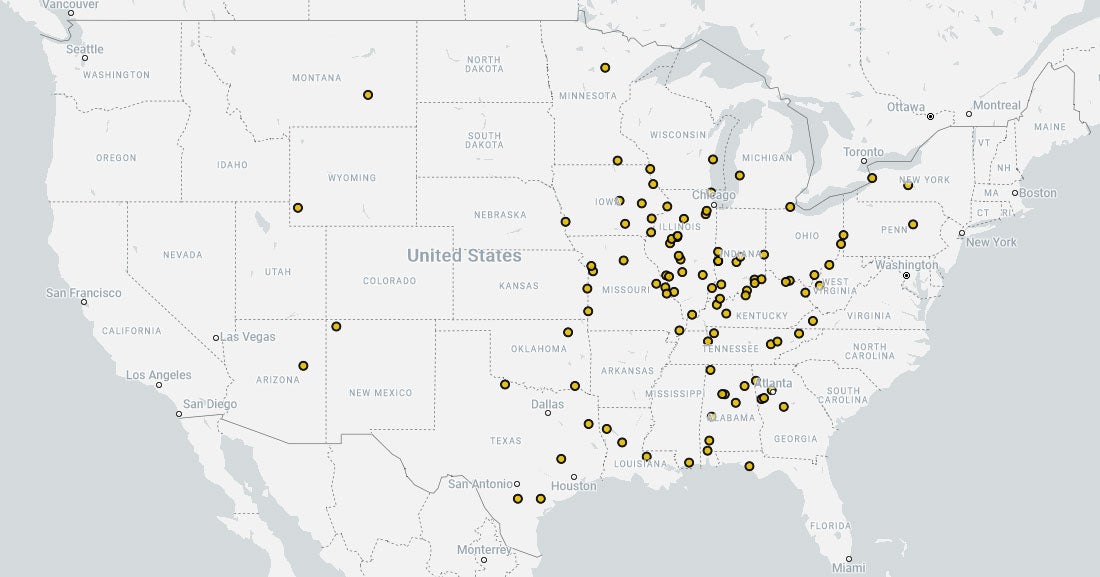June 14, 2022
101 Coal Plants With Toxic Sludge Threatening Our Drinking Water
At the hundreds of coal ash dump sites across the country, the utility industry is skirting the federal coal ash rule to avoid cleaning up coal ash.
This map depicts 101 coal plants that:
- Have toxic coal ash ponds literally sitting in or are dangerously close to the water underground that feeds our rivers, lakes, reservoirs that provide our drinking water, and connect to other waterways;
- Have contaminated the groundwater with heavy metals and other toxins from the waste from burning coal; and
- Refuse to move the toxic waste from the ponds and plan to leave it to continue leaching toxic chemicals for generations.
Analysis by the Environmental Protection Agency reveals there are over one hundred power plants that have dumped toxic waste from burning coal into over 160 storage ponds that are dangerously close to or totally submerged in vital underground drinking water sources. These water sources are called groundwater and are beneath the coal ash ponds. Groundwater is supposed to provide clean water to our lakes, streams, and rivers — as well as our drinking water — because the earth above acts as nature’s filter. But, instead, coal plants are contaminating the water with toxins that cause cancer, lung disease, brain problems, and more.
Burning coal not only worsens the climate crisis, it also contaminates the air we breathe and the water we swim in and rely on for drinking water and fishing.
Around half of U.S. residents rely on groundwater for their drinking water. For decades, utilities have dumped their toxic coal ash in the cheapest way possible, which was often directly into unlined pits dug into the water table where groundwater is found. Typically, these pits are adjacent to rivers, lakes, and streams, allowing hazardous chemicals to flow directly into our waterways. When these pits are near drinking water wells, the contamination from the toxic ash dumps can be drawn directly into our drinking water, poisoning the wells.
In addition to the plants depicted in the map, there are hundreds of other coal ash dump sites that power plants admit also cause water contamination but are not included in the map because this map focuses on those sites in the groundwater or right on top of it where power plants refuse to remove the waste when closing the dump.
At the hundreds of coal ash dump sites across the country, the utility industry is skirting the federal coal ash rule to avoid cleaning up coal ash. Utilities accomplish this by covering up the contamination, indefinitely delaying clean-up, and leaving coal ash where it will leak permanently into our water supplies. We have enough toxic coal ash sitting in leaking ponds and landfills in the U.S. to fill train cars end-to-end that would circle the Earth more than five times.
Most coal plants have done almost nothing to clean up the water contamination at almost all the 738 regulated coal ash dump sites across the country. Only a handful of coal plants have a meaningful plan to clean up the groundwater they’ve contaminated, although hundreds admit they have contaminated this water to unsafe levels.
The plant owners are evading cleanup responsibilities by several ploys:
- They claim the culprit is other coal ash on their property that isn’t regulated due to a loophole;
- They blame some other “unnamed source” or "naturally occurring" chemicals for contaminating groundwater with the same coal ash contaminants that are leaking from their dumps;
- They use tainted water samples near dirty locations on their property as “background” to show that the contaminated water near their regulated coal ash dumps is not much worse; and
- They post “cleanup plans” on their website but never actually initiate cleanup, even years after posting, despite the fact that the federal rule requires plants to choose a cleanup remedy “as soon as feasible.”
Earthjustice is fighting in court and alongside partners in impacted communities for a long-term solution to the toxic menace of coal ash.
Earthjustice’s Clean Energy Program uses the power of the law and the strength of partnership to accelerate the transition to 100% clean energy.
